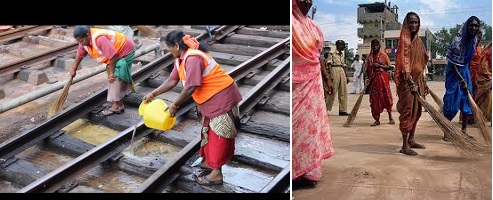| Connecting
over 25-30 millions NRIs worldwide |
|
|||||||||||||||||||||||
|
||
The caste system in India:Untouchable, also called Dalit, officially Scheduled Caste, formerly HarijanThe caste system in India: The caste system divides Hindus into four main categories - Brahmins, Kshatriyas, Vaishyas and the Shudras. Many believe that the groups originated from Brahma, the Hindu God of creation. The word “Dalit” comes from the Sanskrit root dal- and means “broken, ground-down, downtrodden, or oppressed.” Aa caste system is a process of placing people in occupational groups. It has pervaded several aspects of Indian society for centuries. Castes are an aspect of Hindu religion. Other religions in India do not follow this system.
The most biggest problem with this system was that under its rigidity and the lower castes were prevented to climb higher and restricted. 'Untouchables' Are Still Being Forced to Collect Human Waste by Hand: Dalits are the manual scavengers, the removers of human waste and dead animals, leather workers, street sweepers and cobblers. The mere touch of a Dalit was considered "polluting" to a caste member. Thus, the concept of "untouchability" was born.
In India, the people employed to clean such toilets have always been the untouchables or dalits—and 98% of them are women.“People work as manual scavengers because their caste is expected to fulfill this role, and are typically unable to get any other work,” says Meenakshi Ganguly, South Asia director at HRW. “This practice is considered one of the worst surviving symbols of untouchability because it reinforces the social stigma that these castes are untouchable and perpetuates discrimination and social exclusion.”
“The first day when I was cleaning the latrines and the drain, my foot slipped and my leg sank in the excrement up to my calf,” Sona, a manual scavenger in Bharatpur, a city in the northwestern state of Rajasthan, told HRW. “I screamed and ran away. Then I came home and cried and cried. I knew there was only this work for me.”
Dalits are prohibited from eating with other caste members, marrying with other caste members, separate utensils, entering dominant caste homes, seperate seating and food arrangements in village functions and festivals, not to use common village path, separate burial grounds, contesting in elections and no access to village’s common/public properties and resources (wells, ponds, temples, etc.). If any Dalit members made violation of these rules, they may face social boycotts by dominant castes for refusing to perform their “duties.” Dalits regularly face discrimination and violence which prevent them from enjoying the basic human rights and dignity promised to all citizens of India. Caste System can be found in Nepal, Pakistan, Sri Lanka, and Bangladesh, as well as other countries outside of South Asia. More than 300 million people worldwide suffer from this “hidden apartheid” of segregation, exclusion, and discrimination. Our Cast system is still alive and kicking: Every year, we celebrate anniversary of India's independence from UK and it reminds us to be proud of our country’s prolonged battle against colonialism, of the martyrs who gave their blood for India But Hindu, Christian, Buddhist, Sikhs and Jain, carry some vestiges of the caste system in them and ‘untouchables’, oppression and violence are still everyplace in our life. What does freedom mean? Free to be mercilessly thrashed for doing a job thrust forcibly on you, such as skinning dead cows, your destiny because that’s the caste you were born into? Mahatma Gandhi made the lower castes and untouchables a fifth, lowly class with the name Harijan, or references to SC- Scheduled Castes and ST-Scheduled Tribe. India’s Constitution abolished “untouchability,” meaning that the dominant castes could no longer legally force Dalits to perform any “polluting” occupation. Since 1950, the country has enacted many laws and social initiatives to protect and improve the socioeconomic conditions of its lower caste population. These caste classifications for college admission quotas, job reservations and other affirmative action initiatives. Discrimination against lower castes is illegal in India under Article 15 of its constitution, and India tracks violence against Dalits nationwide. To prevent harassment, assault, discrimination and similar acts against these groups, the Government of India enacted the Prevention of Atrocities Act on 31 March 1995. But they were forbidden entry to many temples, to most schools, and to wells from which higher castes drew water. Their touch was seen as seriously polluting to people of higher caste, involving much remedial ritual.
|
||
| |
|
|



